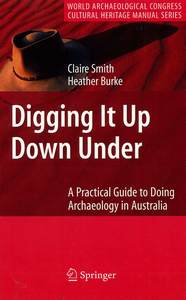Sean Ulm's and Ian Lilley's guide to doing archaeology in Queensland
Ulm, Sean, and Lilley, Ian (2007) Sean Ulm's and Ian Lilley's guide to doing archaeology in Queensland. In: Smith, Claire, and Burke, Heather, (eds.) Digging it Up Down Under: a practical guide to doing archaeology in Australia. World archaeological congress cultural heritage manual series . Springer, New York, NY, USA, pp. 142-143.
![[img]](https://researchonline.jcu.edu.au/17202/1.hassmallThumbnailVersion/17202_Ulm_%26_Lilley_Book_Cover.jpg)
|
Image (JPEG) (Book Cover)
- Cover Image
Download (284kB) |
|
|
PDF (Published Version)
- Published Version
Restricted to Repository staff only |
Abstract
[Extract] • Sources of Information. Historical sites on the Queensland Heritage Register can be searched online at: http://www.epa.qld.gov.au/culturaLheritage/registers_and_inventories. Indigenous sites on the Aboriginal and Torres Strait Islander Cultural Heritage Database or Register can be searched by lodging a search request form available at: http://www.nrm.qld.gov.au/culturaLheritage/search_request/search_request_forms.html.
• Artifacts. The Queensland Museum* is the State repository but lack of space is affecting its ability to fulfil this legislative requirement. The new Acts allow Indigenous owners to keep skeletal material and secret/sacred items, while all other material remains the property of the State.
• Human skeletal material. Must be reported to the police in the first instance.
• Climate. The Far North has a tropical wet/dry climate, hot and dry but comfortable from May to September and hot, dry but humid until December. Inland areas can experience extreme heat during the day in summer and extreme cold at night in winter. The southeast has cool, dry winters, and hot, wet summers,while autumn and spring are perfect. Queensland has Australia's most variable climate, so do not rely on the weather being consistent from one year to the next.
• Access. Most of the State is accessible by road and air, or, in the Torres Strait and other island regions, boat and air. Rain can restrict access in the inland and the north owing to flooding or, especially in black soil areas, impassable boggy conditions. In the Torres Strait, rain can close grass airstrips (though most have been sealed recently) and bad weather (including wind) can stop boat and air travel altogether. Entry to Aboriginal and Torres Strait Islander communities requires permission from local Indigenous councils. Entry to private land requires the landowner's permission as well as permission from the traditional/customary owner if a different person.
• Distance. Rural and especially remote areas are called "rural and remote" for good reason. Make sure you have tested communications and recovery gear and procedures, and adequate water and first-aid supplies, and ensure that you are trained in map-reading and first-aid, as well as 4WD driving, recovery and basic repairs.
• Maps. There are 1:250,000 and 1:100,000 topographic maps available for the whole state and maps at 1:50,(X)0 and better for selected areas. There is also good aerial photo coverage, especially of the coast by the Beach Protection Authority.
| Item ID: | 17202 |
|---|---|
| Item Type: | Book Chapter (Non-Research) |
| ISBN: | 978-0387-35260-2 |
| Date Deposited: | 20 Oct 2011 00:02 |
| FoR Codes: | 21 HISTORY AND ARCHAEOLOGY > 2101 Archaeology > 210101 Aboriginal and Torres Strait Islander Archaeology @ 50% 21 HISTORY AND ARCHAEOLOGY > 2101 Archaeology > 210104 Archaeology of Australia (excl Aboriginal and Torres Strait Islander) @ 50% |
| SEO Codes: | 95 CULTURAL UNDERSTANDING > 9505 Understanding Past Societies > 950503 Understanding Australias Past @ 100% |
| Downloads: |
Total: 1346 Last 12 Months: 5 |
| More Statistics |



